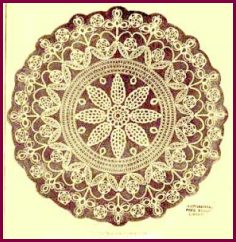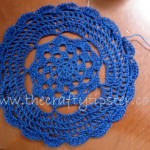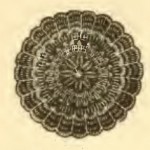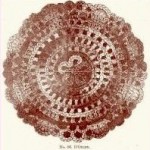I have not tried this vintage crochet doily pattern and after taking a quick look do not believe it is a good choice for a new crocheter as it looks somewhat complicated. If anyone makes this doily, please let me know how well written the pattern is and please consider letting me show off your work here (with full recognition as well).
The crochet “Mat for Flower Vase” is one of several patterns from The Lady’s Album of Fancy Work. This crochet doily pattern, along with a number of other crochet patterns was first published in 1850.
This vintage crochet doily pattern suggests a particular brand of crochet thread and does not mention which size hook to use – I would use bedspread thread or a similar weight cotton and whatever hook size the thread manufacturer suggests.
The stitch names are slightly different then what we use today and the specific threads and colors may no longer be available.
Crochet Doily Pattern Stitches
CHAIN-STITCH OPEN CROCHET. —This consists of five or any uneven number of loops attached by a plain stitch to every third stitch of the foundation, and in the succeeding rows to the centre loop of the chain of previous row.
THREE CHAIN CROCHET.—Work a chain of three loops as in chain-stitch open crochet.
DOUBLE CROCHET.—Work as follows: having made a chain, pass the needle through the first loop on the chain, draw the cotton through the loop, there will now be two loops on the needle, through these draw the cotton.
SINGLE CROCHET.—Insert the needle in the loops, and draw the cotton through this loop and that on the needle.
RIBBED CROCHET.—This is worked in a similar manner to double crochet, only that the under loop of the previous row is taken, and it is done in rows to and fro.
LONG STITCH.—Twist the cotton round the needle, pass it through the loop, draw the cotton through the first two loops on the needle, then catch the cotton again and draw it through the next two loops; there will be one loop left on the needle.
DOUBLE LONG STITCH.—This resembles long stitch, excepting that the cotton is twisted twice round the needle.
TREBLE LONG STITCH.—Twist the cotton three times round the needle.
SINGLE OPEN CROCHET.—This is a succession of long stitches, with a chain-stitch between each, missing one stitch of the foundation; in the succeeding rows the long stitch is worked between the two long stitches of the preceding rows.
DOUBLE OPEN CROCHET.—This consists of two long stitches, then two chain-stitches; or it may be varied by making one long stitch, two chain-stitches, missing the same number of stitches in foundation as there are chain-stitches.
TREBLE OPEN CROCHET.—Work three long stitches, then three chain, missing three of the foundation.
VANDYKE OPEN CROCHET.—Work three long stitches into one of the foundation, make one chain-stitch, miss three of the foundation; repeat. In the next and following rows the long stitches are worked in the chain-stitch.
Vintage Crochet Doily Pattern
Material—Raworth’s crochet thread No. 40.
Centre Flower.—12 c s, unite, work into this ring 5 c s, 1 l s, * 2 c s, 1 l s; repeat from * eleven times, finish with 2 c s, s c into third stitch of first, 5 c s.—
2d round. D c into first space, * 5 c s, d c into next space; repeat from * into every space, finish with 5 c s, s c into first d c of the round.—
3d round. 5 d c round every loop of 5 c s in last round.
The eight crochet Leaves round this Flower.—Commence on one of the stitches at the edge of this flower, 25 c s, s c back (this is for the stripe in the centre of leaf), * 5 c s, miss 3, d c into fourth; repeat from * five times, which brings it to top stitch of leaf, 6 c s, d c into same stitch, 5 c s, miss 3, d c into fourth six times down the other side of the stripe, draw out the loop on the needle a little, pass the thread under the leaf, 1 d c round the first loop, 5 c s, d c round the next loop, * 6 c s, d c round the next; repeat from * four times, which brings it to top loop, 7 c s into same top loop, 6 c s into five more loops down the other side, 5 c s, d c into last loop, pass the thread under the leaf, d c three times round the loop next to stripe, five times round next loop, six times round every loop up to the top, 2 d c, 5 l s, 2 d c round the top loop, 6 d c round every chain of six down the other side, 5 d c round chain of 5, 3 d c round the last loop at bottom of leaf next to the stripe; fasten off. Make another leaf in the same manner at the opposite side of the centre flower, and one at an equal distance between these two; another on the other side to correspond, which will make four leaves, then work four more leaves between these 4, and the eight leaves will be finished.
For the rounds of open crochet work proceed thus: Commence on the point of one of the leaves, work 29 c s, d c into point of next leaf; repeat this all round, not making the c s too tight.—
2d round. D c into every stitch of this round.—
3d round. 1 l s, * 3 c s, miss 2, 1 l s into third stitch; repeat from *.—
4th round. D c into every stitch of last round.—
5th round. 1 l s, * 3 c s, miss 2, 1 l s into third stitch; repeat from *.—
6th round. D c into every stitch of last round.—
7th round. 1 l s, 2 c s, miss 2, 1 l s into third; repeat from * all round.—
8th round. D c into every stitch of last round. Work on the inside of the first round of 29 c s a ring, thus: commence on centre, c s between the leaves, 16 c s, unite on foundation-stitch, d c twenty-four times round this ring; repeat these rings between every two leaves, making eight in all.
The crochet Leaves on the outside of the open Rounds.
— Commence on stitch opposite to the point of one of the large leaves. 18 c s, 1 l s into sixth stitch, * 2 c s, miss 2, 1 l s into third; repeat three times more from *. 1 s c into foundation-stitch, then 4 d c round first loop; 1 d c, 2 l s, 1 d c round next three loops, 1 d c, 4 l s, 1 d c round top loop; 1 d c, 2 l s, 1 d c round three loops on the other side of leaf; 4 d c round last loop. Make another leaf in the same manner, beginning at the same foundation-stitch. Fasten off. Then two more leaves exactly the same, opposite the points of all the large centre leaves. Then two more leaves opposite each of the d c rings inside the open rounds (which will be at an equal distance on each side from the others). There will now be thirty-two small leaves, two and two, the upper point of each leaf to be turned outwards, and to be tacked with needle and thread to the point of the next leaf, which it will meet easily. (Care must be taken to refer to the engraving for the manner in which the mat is to be finished, as it will greatly assist the explanations.)
For the small crochet roses between the leaves, which are made separately: 9 c s, unite, 5 c s, 1 long stitch into ring, * 2 c s, 1 l s; repeat from * seven times. 2 c s, s c into third stitch of first 5 c s.
2d round. 1 s c round first space, 3 c s, 3 l s, into same space, * 5 c s, miss 1 space, 4 l s into next space; repeat from * all round. Finish with 5 c s, s c into third stitch of 3 c s. Fasten off sixteen roses for the round. Place one of these roses between every pair of the leaves which proceed from the same foundation, and sew it at the edge to the third scallop of the leaves; then commence between the points of the leaves which were sewn together, * 24 c s, d c into centre of edge of small rose, 24 c s, d c between the points of the leaves; repeat from * all round, then 26 d c stitches round every 24 chain.
Sprigs between the 24 C S.—18 c s, unite on twelfth. D c round this loop twenty-two times. S c up remaining c s for stalk. Fasten off, leaving an end to sew the sprig on the mat. Turn wrong side up. Commence on fifth stitch from stalk on the right-hand side of the flower, * 10 c s, unite in same stitch. Turn again. Into this circle work 18 d c stitches *. Turn wrong side up. S c up to top of ring formed by 18 c s; repeat from * to * for another ring. Turn wrong side. S c down to fifth stitch from stalk. Repeat another ring, when the work will be on the right side. Bring the cotton to the side of this last ring nearest to stalk. 13 c s, s c into top of last ring. 6 c s, s c into same stitch. 13 c s, s c into foundation close to the lower part of ring. 5 c s, s c into foundation-ring, close to centre ring, at the top. 13 c s, s c into top of ring; 6 c s, s c into same stitch; 13 c s, s c into foundation at bottom of ring; 5 c s, s c into foundation at lower part of next ring; 13 c s, s c into top of ring; 6 c s, s c into same stitch; 13 c s, s c into foundation at the other side of ring. Fasten off. Sixteen of these sprigs are required, and sixteen more small roses. Place one sprig between each of the chains of 24 d c, where they meet at the points of the leaves, and sew them by the thread which was left at the end of the stalk. Confine them to the 24 d c by the lower 13 c s. Place a small rose between each of these sprigs, fastening them together where they meet. The best way is, to cut out a circle in coloured paper, and (after the crochet work is completed) place the mat wrong side up upon it, and fasten the flowers to it and to each other, as it will then be quite flat and smooth.





I have been working on making this item. The pattern is written with old fashioned terms and is a challenge to understand. You are correct in stating that this pattern isn’t a good choice for a new crocheter. So far I have completed the center flower and the eight leaves, and I am now on the rounds of open work. Using size 10 thread, the center of the doily, from leaf tip to leaf tip is 9 inches across, with lots of open space between the leaves. I estimate that if I ever actually finish the doily it will be around 27 inches across. If a person were to use the size 40 thread that was recommended in the pattern it would make a much smaller doily. Hope this info helps 🙂
Hi Cheri,
Thanks for stopping by. I had been thinking about giving this pattern a go myself. Perhaps only making it up to the internal ring with the picots on it – about where you are in the pattern.
The size information is super helpful as with so many of these vintage patterns, there is often no indication of finished size. Based on what you’ve said, I wonder if this pattern was originally designed for a tablecloth for a small tea table or something of that nature.
Please let me know if you ever do finish as I would love to post a picture of what it looks like completed in modern threads/yarn.
Good luck on figuring out the rest of this doily pattern as it looks like the really hard part is after those central rings that you are now working on.
Regards,
Michele
I Love a good challenge. Often I create my own patterns, Today is August 7, 2009. Please e-mail me an e-mail addy to send my picture of this doily by next week. I was browsing the internet for unique items to enter into our local county fair, this doily will do very nice in our fair. Thank you and I hope to communicate more with you in the future.